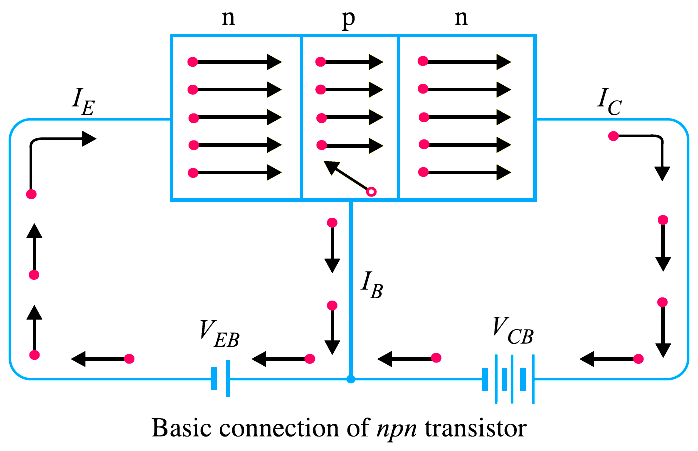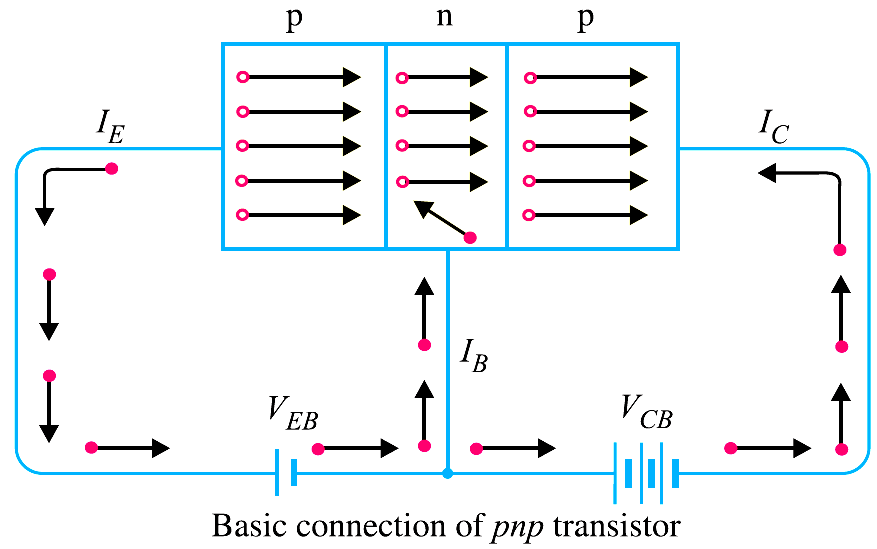The emitter-base junction of a transistor is forward biased whereas collector-base junction is reverse biased. If for a moment, we ignore the presence of emitter-base junction, then practically (Note 1) no current would flow in the collector circuit because of the reverse bias. However, if the emitter-base junction is also present, then forward bias on it causes the emitter current to flow. It is seen that this emitter current almost entirely flows in the collector circuit. Therefore, the current in the collector circuit depends upon the emitter current. If the emitter current is zero, then collector current is nearly zero. However, if the emitter current is 1mA, then collector current is also about 1mA. This is precisely what happens in a transistor. We shall now discuss this transistor action for npn & pnp transistors.
Working of npn transistor
The Below Fig shows the npn transistor with forward bias to emitter-base junction and reverse bias to collector-base junction. The forward bias causes the electrons in the n-type emitter to flow towards the base. This constitutes the emitter current IE. As these electrons flow through the p-type base, they tend to combine with holes. As the base is lightly doped and very thin, therefore, only a few electrons (less than 5%) combine with holes to constitute base (note 2) current IB. The remainder ( (Note 3) more than 95%) cross over into the collector region to constitute collector current IC. In this way, almost the entire emitter current flows in the collector circuit. It is clear that emitter current is the sum of collector and base currents i.e.
IE = IB + IC

Note:
- In actual practice, a very little current (a few µA) would flow in the collector circuit. This is called collector cut off current and is due to minority carriers.
- The electrons which combine with holes become valence electrons. Then as valence electrons, they flow down through holes and into the external base lead. This constitutes base current IB.
- The reasons that most of the electrons from emitter continue their journey through the base to collector to form collector current are : (i) The base is lightly doped and very thin. Therefore, there are a few holes which find enough time to combine with electrons. (ii) The reverse bias on collector is quite high and exerts attractive forces on these electrons.
Working of PNP transistor
The below Fig shows the basic connection of a pnp transistor. The forward bias causes the holes in the p-type emitter to flow towards the base. This constitutes the emitter current IE. As these holes cross into n-type base, they tend to combine with the electrons. As the base is lightly doped and very thin, therefore, only a few holes (less than 5%) combine with the electrons. The remainder (more than 95%) cross into the collector region to constitute collector current IC. In this way, almost the entire emitter current flows in the collector circuit. It may be noted that current conduction within pnp transistor is by holes. However, in the external connecting wires, the current is still by electrons.

Importance of transistor action
The input circuit (i.e. emitter-base junction) has low resistance because of forward bias whereas output circuit (i.e. collector-base junction) has high resistance due to reverse bias. As we have seen, the input emitter current almost entirely flows in the collector circuit. Therefore, a transistor transfers the input signal current from a low-resistance circuit to a high-resistance circuit. This is the key factor responsible for the amplifying capability of the transistor.
